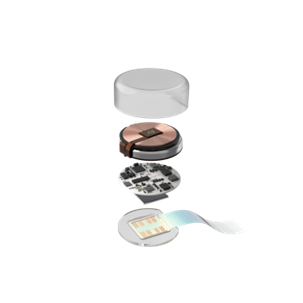In his latest guest blog for Quay Crew, Scott Molloy of Superyacht Electronics Academy, delves into the future of wearable tech onboard.
Items such as smart watches already exist, of course, but I believe we are in the dawn of a new age of wearable tech. Continued miniaturisation is now really leading to smaller, lighter components that are more discreet and wearable.
You might have heard of Moore’s Law. In 1975, Intel co-founder, Gordon Moore, predicted that the number of transistors that can be built into a microchip would double every two years. It did and continued to do so. The result; comparatively smaller, faster and more efficient chips leading to an exponential increase in chip processing power over the years.
A recent breakthrough was the 5 nanometre (5nm) chip manufacturing process. The first commercial 5nm chip was Apple’s A14 CPU in the iPhone12 in 2020. Every iPhone since, and many other devices, have featured 5nm generation processors.
However, chips based on a new 3nm manufacturing process are now on the horizon. Expect to hear all about new 3nm generation products over the next 12 months. And, potentially, even 2nm based products appearing a year or two later!
User Interfaces on Superyachts
Convenience is king with lifestyle technology. Where technologies promise us more efficiency, they tend to be very successful. Such benefits usually come at some cost or other, but generally this is the way of things.
Yet the de facto user interface onboard remains a touch screen, such as an iPad. I’ve recently written about the deficiencies of these “hands on” user interfaces. I also predicted within five years they will only exist as a backup.
The most convenient interface is actually no physical interface at all. Stopping what you are doing, to search for a perhaps unfamiliar controller is never going to be the ideal solution. This is why voice control solutions and wearable tech have grown so fast in popularity. Another big limitation, however, is that current interfaces typically know very little about the system users themselves.
Take onboard climate controls for example. A static temperature gets set for a room. But the system doesn’t actually know anything about the people in the room. Or even if anybody is there at all. No surprise then, that the temperature is “never quite right”.
The systems really need to know more about us. A new breed of discreet wearable tech makes the possibilities to optimise the onboard systems and experience endless. Not to mention convenience gains and addressing the operator’s never-ending frustration with the user interface.
Think smart prescription glasses or jewellery. Potentially any accessory or clothing can have discreet components embedded. Of course, other component technology will continue to miniaturise and develop too. And no, a battery is not always needed.
Mind Control?!
Last year, I speculated that we might soon be interfacing with systems simply using the power of our minds. This was entirely hypothetical at the time. However, I since realised just how close this really is.

Currently we carry mobile devices and some intelligent wearable tech. But in the near future I believe convenient implantable devices will become a normal option too. If something is technologically possible and offers at least some kind of perceived convenience, it is unlikely to be a commercial failure.
If this still sounds a bit far-fetched, perhaps you haven’t heard of the company Neuralink or their product The Link yet. Although you will have certainly heard of one of the company’s founders, Elon Musk.
Does small wearable tech cause big problems?
There is a big caveat with miniaturisation. Because Moore’s Law did eventually run into some pretty “BIG” problems. Debates continue around whether it is actually already dead. Transistors can’t really continue to be made much smaller, or perhaps not in a commercially viable way.
A lot of the debate hinges on individual interpretation of Moore’s Law. In 2015, Moore himself did estimate within 10 years Moore’s Law would effectively be dead based upon miniaturisation limits of transistors at the atomic level.

The answer is to find a replacement for the silicon-based transistor. Research continues in different areas, such as using alternative atomically thin materials.
So it could be that the spirit of Moore’s Law lives on, but is reborn in new manufacturing processes.
It is inconceivable that computing power will plateaux. What or who else is going to process all this data?
As Moore also said: “Engineers will always find a way”.
Scott is an ex superyacht AV/IT Officer for 5 large superyachts/builds 88-180m. Scott now runs Superyacht Electronics Academy, a dedicated Superyacht AV/IT training service.




